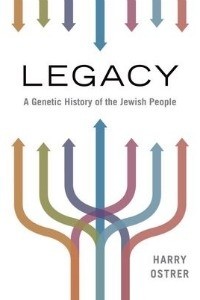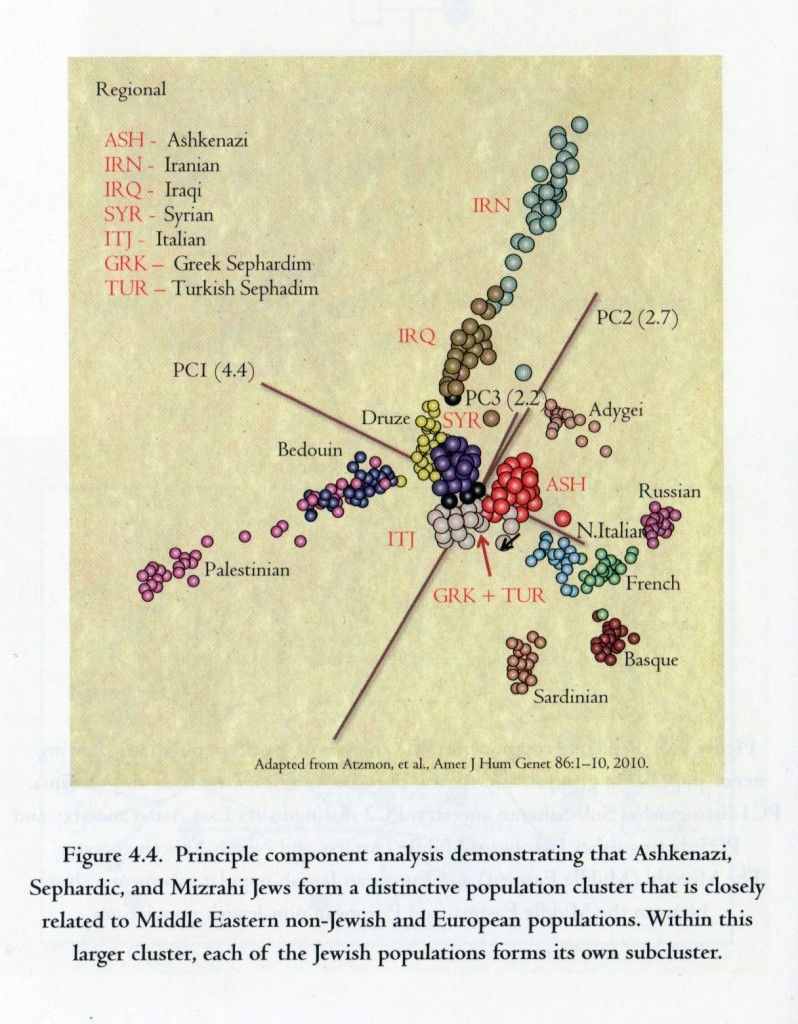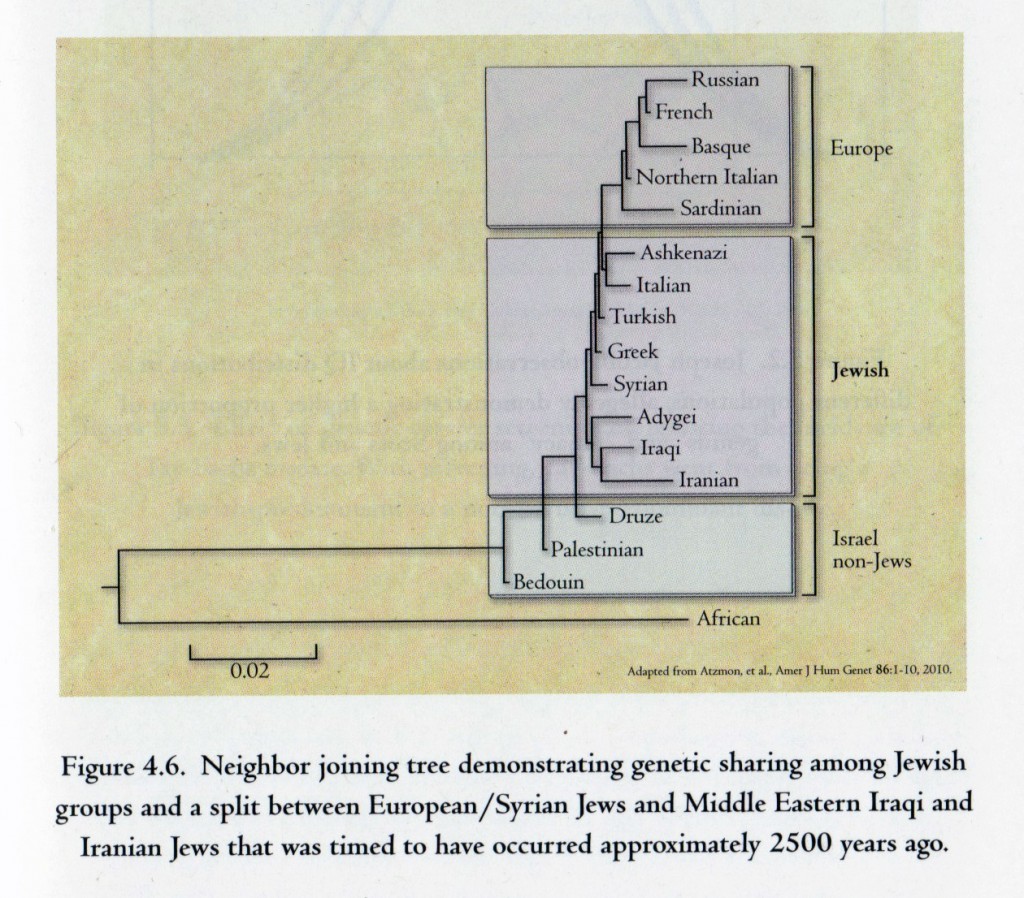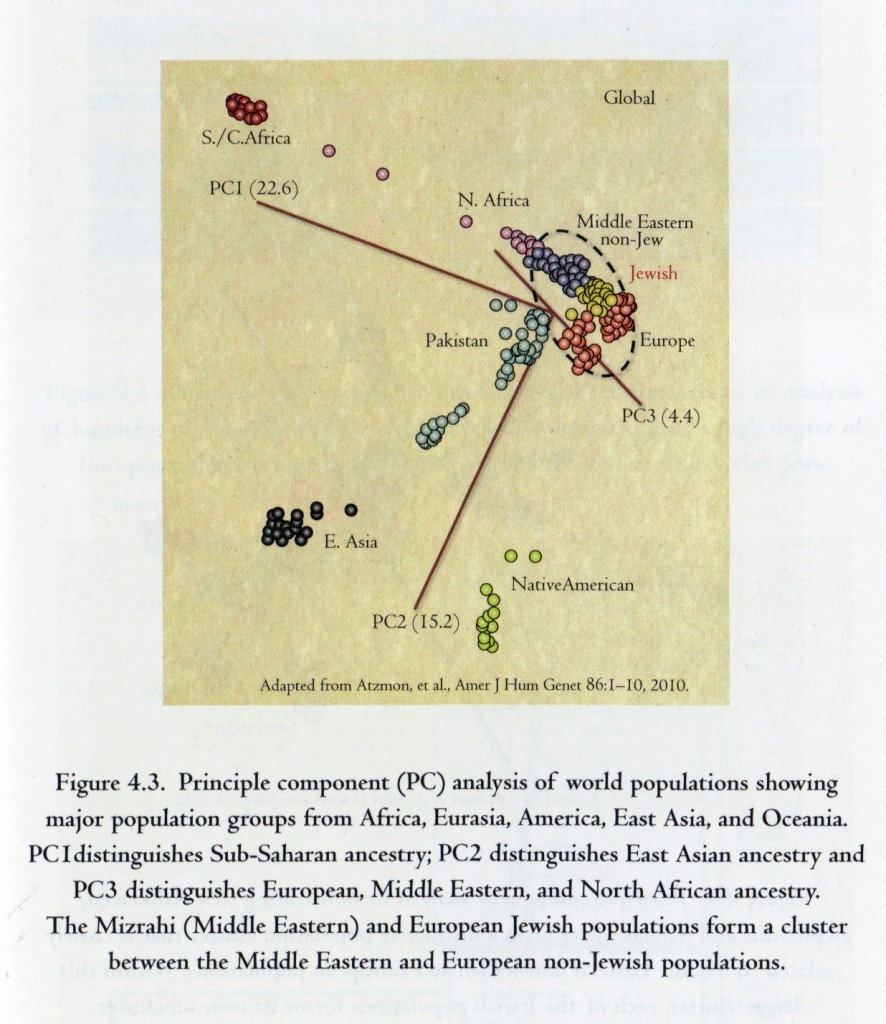Who are the Jews?
 Legacy: A Genetic History of the Jewish People
Legacy: A Genetic History of the Jewish People
Harry Ostrer
Oxford University Press: 2012
288pp., $24.95
Are Jews a religion or race?
This is the age-old question that medical geneticist Harry Ostrer tackles in his concise but informative book, Legacy: A Genetic History of the Jewish People.
As Professor of Pathology and Genetics at Albert Einstein College of Medicine of Yeshiva University and Director of Genetic and Genomic Testing at Montefiore Medical Center, as well as former Director of the Human Genetics Program at New York University’s School of Medicine, Ostrer has devoted much of his career to unraveling the DNA sequencing of recessive genetic disorders common among Jews, such as Tay-Sachs and Gaucher disease. After two decades of medical research, he explains that Jews share more than religious and cultural traditions — a common biological bond links Jews throughout the Diaspora.
This body of work has led Ostrer to conclude that Jews are genetically related worldwide. Three millennia of selective breeding have created a distinct population with unique racial characteristics. Within this broad isolated population, diverse ethnic tribes formed and branched out. Mutual genes serve as the ancestral linkage between major Jewish tribes: Ashkenazi (who are related to one another on average as fifth cousins), Sephardic, Eurasian Khazars, Middle Eastern, and Mizrahi or African Jews.
Legacy is a slim book that incorporates history, natural selection, population genetics, evolutionary psychology, and contemporary medical findings. The author’s quest for the basis of Jewish origins and identity forms the basic storyline of Legacy. Each chapter highlights various aspects of Jewish ancestry: physical measurements and characteristics, DNA studies, blood groupings, genealogical evidence, tribal lineage, physical and psychological traits, and, finally, the crux of Jewish identity. The result is an informative overview of 25 years of detective work unraveling the genetic kinship of Jews.
Ostrer reviews the work of early Jewish pioneers who were at the forefront of pinpointing the biological origins of Jews. Maurice Fishberg, a Russian Jew who settled in New York in 1889, was a physician and anthropologist who studied Jewish physical traits. Fishberg, according to Ostrer, found that Jews had a darker pigmentation than Gentiles, but rejected the idea that Jews constituted a distinct race. He put forth his theories in, Physical Anthropology of the Jews (1902) and Jews: A Study of Race and Environment (1911). Ostrer notes,
Fishberg, nonetheless, perceived the presence of a Jewish physiognomy, or look, and filled his book with photos of Jews from all over the world, who, to his eye, resembled one another. As he said, “One can pick out a Jew from among a thousand non-Jews without difficulty.”
Unlike Fishberg, Joseph Jacobs — a prominent physical anthropologist, editor of the Jewish Encyclopedia, and contributor to the Encyclopædia Britannica — was a “proponent of the view that Jews constituted a single race.” Jacobs argued, “The remarkable unity of resemblance among Jews, even in different climes, seems to imply a common descent.”
Ostrer explains how technological advances in genomics allow researchers to tease out population differences and migration patterns to the degree that it is possible to identify genetic subclusters in diverse populations. Research developments in the past decade have boosted the Jewish HapMap Project, the major research endeavor the author has spearheaded with his colleagues.
Luigi Luca Cavalli-Sforza and other geneticists developed and refined “analytical methods that would quantify the differences between populations.” Researchers have applied two statistical methods — genetic distances and dendritic trees — in analyzing combined genetic data. The greater the genetic distances for any population, the more disparate the population. Further genomic advances have enabled researchers to identify more detailed sources of genetic variation, namely copy number variants (CNVs) and single nucleotide polymorphisms (SNPs), which track “variations in the number of copies of a gene or a DNA sequence along a chromosome.” In utilizing these new research tools, geneticists have been able to trace the degree of genetic similarity across different Jewish groups in areas where the populations are genetically heterogeneous. Ostrer points out,
The Jewish HapMap Project demonstrated in exquisite detail what had been conjectured for a century. Jewish populations from the major Jewish Diaspora groups — Ashkenazi, Sephardic, and Mizrahi — form a distinctive population cluster that is closely related to Semitic and European populations (figure 4.4). Within this larger Jewish cluster, each of the Jewish populations formed its own subcluster. Each group demonstrated Semitic ancestry and had variable degrees of admixture with European populations.
In his concluding chapter on Jewish “Identity,” Ostrer summarizes the central point of his work:
The evidence for biological Jewishness has become incontrovertible. The answer to Jacobs’ 1899 question, “Are Jews Jews?” would seem to be an emphatic yes. As noted earlier, a study by Goldstein and his coworkers demonstrated that it was possible to predict full Ashkenazi Jewish ancestry accurately and with a somewhat lesser degree of certainty for people with one, two, or three Jewish grandparents. The Jewish HapMap Project has extended these findings to people who come from virtually all other Jewish groups, each group representing a genetic cluster that can be defined as a predominant pattern of inheritance that includes a large number of genetic markers. The findings are based on the fact that segments of the genome tend to be shared at a higher frequency among members of different Jewish groups. This degree of shared genetic segments is greater among Jews than between Jews and non-Jews. So Jewishness at a genetic level can be characterized as a tapestry with the threads represented as shared segments of DNA and no single thread required for composition of the tapestry.
The fate of the Khazars — a semi-nomadic people of Central Asian Turkic origin in the area of Southern Russia, which was ruled by a succession of Jewish kings from essentially the eighth to the eleventh century — “has been the subject of much speculation,” as Ostrer notes, not to mention a source of contention among Jewish scholars. Jewish Historian Abram Leon Sachar notes, “In the eighth century a whole Tartar kingdom, the Khazars, in South Russia, had been converted to Judaism, and maintained an independent and successful existence for more than two centuries, until it fell, in 969, before Sviatoslav, the Duke of Kiev.”
Arthur Koestler’s The Thirteenth Tribe, published in 1976, reignited the debate over the origins of East European Ashkenazi Jews, which he believed were primarily descendants of Khazars. Koestler rejected the idea that Jews were a race (he cited Fishberg’s work as supporting evidence), but also argued, “there exist certain hereditary traits which characterize a certain type of contemporary Jew. In the light of modern population-genetics, these can to a large degree be attributed to processes which operated for several centuries in the segregated conditions of the ghetto: inbreeding, genetic drift, selective pressure.”
Notwithstanding Koestler’s convoluted mental contortions, such a claim is actually compelling evidence for the racial hypothesis rather than evidence to the contrary. Koestler’s notion about race reflects typical misconceptions about the concept — a view endemic among sociologists and social anthropologists, which include contemporary disciples of Franz Boas and Margaret Mead. As a scientist firmly grounded in biology and population genetics, Ostrer for the most part avoids these fallacies about race.
In concluding The Thirteenth Tribe, Koestler summarized his view that contemporary Jews were substantially the descendants of Khazars:
It would of course be foolish to deny that Jews of different origin also contributed to the existing Jewish world-community. The numerical ratio of the Khazar to the Semitic and other contributions is impossible to establish. But the cumulative evidence makes one inclined to agree with the consensus of Polish historians that “in earlier times the main bulk originated from the Khazar country”; and that, accordingly, the Khazar contribution to the genetic make-up of the Jews must be substantial, and in all likelihood dominant.
Shlomo Sand, in his 2009 book, The Invention of the Jewish People, provides some historical documentary evidence in support of Koestler’s theory (see my review). Sand, like Koestler, strongly rejects the racial hypothesis of Jewish origins. He views Jewish history through an egalitarian prism in which races are social constructs and refers to the Jewish race theory as “Mythistory.”
Ostrer briefly mentions the Khazar controversy. After skimming through the history of the Khazars, he believes the findings from the Jewish HapMap Project refute “the theories that Ashkenazi Jews are the descendants of converted Khazars or Slavs.” In Ostrer’s view, Koestler propagated the Khazar theory to diffuse Biblical “anti-Semitism” (the “Christ-killer” accusations popular among some Christians) by claiming that most contemporary Jews had historical ties to Euro-Asian Khazars rather than ties to Palestine.
In addition to the Khazar dispute, Ostrer’s account skillfully navigates through a minefield of other sensitive, politically volatile areas that for many Jews have been a source of contention. Jean-Paul Sartre’s remark that the “Jewish community … is based neither on nation, land, religion … nor material interest, but only on an identity of situation” comes to mind. In his Anti-Semite and Jew, Sartre reflected the views of many liberal Jews in rejecting the notion that this common bond is “ethnic” or racial. Hence, according to Sartre, “the Jewish community is neither national nor international, neither religious, nor ethnic, nor political: it is a quasi-historical community” (emphasis in the original).
The mere suggestion that Jews are a race has prompted accusations of “anti-Semitism” over the years. In contrast to Ostrer’s sober analysis, Alan Steinweis, author of Studying the Jew: Scholarly Antisemitism in Nazi Germany (see the review by Dan Michaels), summarizes the work of prominent Third Reich-era scientists in the chapter, “Racializing the Jew.” Several scholars affiliated with the Kaiser Wilhelm Institute for Anthropology, Human Heredity, and Eugenics come under scrutiny in Steinweis’s account, namely Hans F. K. Gunther, Erwin Baur, Fritz Lenz, Eugen Fischer, and Otmar von Verschuer — scientific pioneers in the field of Rassenhygiene who examined the racial origins of Jews (see also Tom Sunic’s “Race and Religion: Awkward Friends of the White Man,” especially Part III).
Ostrer admits that his major study from 2010, published in the American Journal of Human Genetics, which analyzed DNA markers of 237 Ashkenazi, Middle Eastern, and Sephardic Jews for genetic similarity, sparked denial in some Jewish quarters and insinuations of anti-Semitism in others. Some remarked that “Hitler would have been pleased” with the findings from Ostrer’s team of researchers. The notion that medical researchers could tease out the genetic basis of Jewish ancestry without insidious references to “gas chambers” and “crematoria” decades after the Third Reich has invited a torrent of criticism. Context, perception, and the milieu of persecution and genocide separate Ostrer’s Legacy from the hyper-didactic genre of “Holocaust Studies” literature. The author refreshingly sticks to the relevant subject matter in readable prose largely free of technical jargon.
A central point that John Glad emphasizes in Jewish Eugenics came to mind while reading Legacy. The pursuit of medical advances in understanding the genetic code of various debilitating diseases — and the eventual development of cures via gene therapy — raises the specter of eugenics. Jews have been at the forefront of both cutting-edge research in medical genetics and the eugenic application of such research while actively opposing any broad-based, publicly supported eugenic revival. No one has done more to advance and setback eugenics than Jewish intellectuals; Jews have pioneered the use of medical discoveries and technology for eugenic purposes and as social scientists condemned eugenics as a “bogus” science. It is a glaring double standard — being able to have your cake and eat it too.
Nonetheless, Legacy amplifies a couple of crucial points that Jews have historically rejected or denied. First, despite some slight ambiguities, Ostrer intuitively recognizes that race is a biological phenomenon and that racial and ethnic differences are real. He mentions the important work of Arthur Mourant, “one of the foremost cataloguers of blood groups during the twentieth century” and author of The Genetics of the Jews. Francis Galton, the founder of eugenics, also receives favorable mention. In so far as Legacy explores the matter of race, the approach is balanced, reasonably accurate, and rests on sound biological facts.
Second, the author acknowledges a genetic foundation of some psychological traits, such as intelligence and mental illness. There is an “on the one hand, on the other hand” approach in Ostrer’s chapter on traits, but the coverage is a largely instructive and balanced review of the literature, citing the findings in The Bell Curve as well as Cochran, Hardy and Harpending’s work on the high IQs of Ashkenazi Jews. Regarding IQ and genetic influences on intelligence Ostrer concludes,
Despite much criticism, the notion that general intelligence and its proxy, IQ, are genetically determined has not faded. The assumption of a heritable basis for IQ and for other traits has come from studies of identical twins reared together and apart. The value of studying twins for sorting genetic and environmental effects has been appreciated since Galton published his paper, “The history of twins, as a criterion of the relative power of nature and nurture,” in 1876.
However, Legacy isn’t without its shortcomings. Cyril Burt’s work is briefly mentioned, specifically one of Burt’s studies that compared the test scores of Jewish versus non-Jewish students from three London schools. (Burt concluded that the Jewish students were more advanced for their age.) Ostrer then wades into the allegations of fraud that Leon Kamin, Oliver Gillie, and Stephen Jay Gould leveled against Burt (well-publicized statistical anomalies in Burt’s 1966 paper on identical twins reared apart) after Burt’s death in 1971.
Cyril Burt’s reputation as a towering figure in British psychology came under attack from environmentalist critics (anti-hereditarian skeptics of IQ) and Burt’s official biographer Leslie Hearnshaw (1979) with allegations of fraud in the mid-1970s. Two books — one by Robert Joynson, The Burt Affair (1989), and the other by Ronald Fletcher, Science, Ideology and Media: The Cyril Burt Scandal (1991) — refuted the charges of fraud brought by Burt’s critics. A third monograph edited by N. J. Mackintosh, Cyril Burt: Fraud or Framed?, failed to reach a consensus among the contributors, all well-known experts in the field of educational psychology. (Most of the contributors found insufficient evidence of fraud in Burt’s twin studies research.) J. Philippe Rushton has offered supporting evidence in Burt’s defense in the introduction of a published transcript of one of Burt’s speeches from 1964 on “The School Psychological Service: Its History and Development.” Burt sheds some light on the “careful record of the after-histories of almost every case referred to me.”
It should be noted that Burt’s papers were destroyed by one of his assistants shortly after his death on the advice of Liam Hudson, one of Burt’s staunchest critics. Had Burt’s papers survived, it is quite likely that the allegations against Burt would not have any evidentiary foundation. As to whether the inconsistencies in Burt’s work are the result of intentional deception or random statistical incongruities or unintentional sloppiness (“muddle a-plenty of a minor nature” as W. D. Hamilton noted) it is unlikely that any definite conclusions will be reached without further corroborating evidence. One thing is certain — the charges against Burt remain unproven.
Ostrer fails to mention these developments in the Burt case as if the story ends with Gould’s biased account in The Mismeasure of Man, a book that has recently come under scrutiny for deceptively false information. The point isn’t a relatively minor one since neglecting a substantial body of counter evidence, and relying largely on a discredited critic’s biased account (Gould), calls into question the author’s thoroughness and accuracy in assessing the matter under discussion, even if a tangential topic. Despite this shortcoming, Legacy remains by and large an informative and useful study on the genetic ancestry of Jews.
Cooper Sterling [email him] is a freelance writer in the Washington, D.C. area.








Comments are closed.